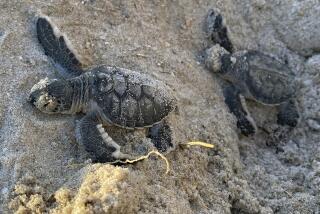The Blood of Turtles Stains Bali
TANJUNG BENOA, Indonesia — Time was running out for the green sea turtles. Four of them lay on the concrete floor of a Bali slaughterhouse, their front flippers tied together so they couldn’t crawl away. Another lay on its back, unable to move.
An empty shell, still wet with blood, rested in a corner as Soleh the butcher squatted by an open fire, cooking the meat of the animal on skewers. The turtle’s destination: a Hindu celebration at nearby Udayana University.
In most of the world, green sea turtles are considered endangered. Here in Bali, they are considered a moneymaker.
Despite the island’s image as a tropical paradise, Bali’s inhabitants slaughter more endangered sea turtles than anyone else in the world, environmentalists say, bringing the species ever closer to extinction.
The killing is especially callous--the turtles are cut apart while they are alive to make it easier to extract the meat from the shell. Like humans’, the eyes of a turtle can water. While the animal is being butchered, it looks as if it’s crying.
The trade in green sea turtles remains a $1-million business despite a law enacted by the Indonesian government in January 1999 making it illegal to catch, possess or eat the animals.
“It’s a very old tradition, and it’s very hard to change,” said Ketut Sukada, a leading advocate of turtle hunting. “It’s the wrong solution to stop people from eating sea turtles.”
In Bali, officials created a huge loophole by allowing hunters to catch 5,000 green sea turtles a year. In practice, this meant there was no limit on the number caught because the quota was never enforced. Agus Haryanta, the top enforcement officer for turtles in Bali, estimates that the hunters catch and kill 15,000 to 20,000 a year.
Further threatening the species’ survival, resort hotels and other buildings constructed in Bali during the past three decades have overrun most of the beaches where turtles once laid their eggs.
“Some people say the green sea turtle is endangered, but I don’t think so,” said Widja Zakaria, one of Bali’s biggest turtle traders. “We try to hunt the sea turtle only in areas where there is a lot. If the numbers are declining, we move to an area where there are more.”
Bali, the only Indonesian island that is predominantly Hindu, enjoys a reputation for friendliness and tranquillity. With its grand tourist resorts and international airport, it has escaped much of the violence that has rocked Indonesia in recent years. But under the surface, Bali has its share of tension.
The bloodletting elsewhere in the country has kept tourists away, and the loss of business has left some Balinese merchants desperate. The average monthly wage is less than $50, and poverty is widespread. Outside the tourist centers, villagers eke out a simple living from terraced rice paddies.
Large Turtles Mean Good Money
In coastal villages such as Tanjung Benoa, impoverished islanders believe it is their right to harvest nature’s resources, whether by catching endangered sea turtles or by using explosives to kill reef fish. One large turtle can fetch the equivalent of more than two months’ pay for an ordinary worker.
In fact, recent attempts by the authorities to curb the turtle trade have led to ugly clashes. In February, a mob of turtle hunters burned down the small police station in Tanjung Benoa, minutes from the major resort district of Nusa Dua. Police say they know who was responsible but haven’t made any arrests out of fear for their own safety.
“Balinese are very friendly, but when there is pressure, they will fight back,” said Putu Lisa, a World Wildlife Fund staff member who said she was threatened with rape if she continued to campaign for the turtles.
Much of the debate over turtle hunting revolves around religion. Balinese Hindus believe that the turtle is a sacred animal that supports the island on its back. Few, if any, of the turtle hunters are Hindus--they are mainly Muslims and Christians who come from other islands.
According to Balinese Brahman High Priest Gede Ngurah Kaleran, the Hindu religion doesn’t require the killing of any turtles.
The animal’s meat isn’t used in Hindu rites, he says. On rare occasions, turtles are sacrificed for ceremonies and their heads are displayed to symbolize the powerful god Vishnu. But this use of turtles comes from a centuries-old mistake in translating the scriptures, he said.
In India, where the religion originated, turtles aren’t sacrificed. In Bali, he says, priests could use ducks or pigs in place of turtles.
“In the Hindu religion, there is no mention of using the turtles, but of honoring the family of turtles,” the priest said. “Turtle meat is not used for the religious ceremony. It’s just for consumption.”
Eating sea turtle is a big part of Balinese celebrations, and the Balinese are big on celebrating. The staging of elaborate ceremonies with traditional dress and sacred rites is a way of keeping Balinese culture alive in a predominantly Muslim country.
Every day brings a reason to party: weddings, pregnancies, cremations, temple purification, teeth filing and other rites of passage. No proper Balinese host would be caught without turtle on the table, a sign of wealth and prestige.
Turtle lovers say the meat is delicious and that young turtle is best of all. Ground up and mixed with spices such as chili and black pepper, it’s usually served on skewers as turtle satay and goes well with arak, a Balinese rice wine.
Turtle is also offered daily at small restaurants and on street carts in Denpasar, Bali’s capital. Usually it isn’t listed on a menu but is available to those who ask.
There are seven oceangoing turtle species, and all are listed as endangered under the Convention on International Trade in Endangered Species. Indonesia, home to six of the seven species, signed the treaty in 1979.
The only kind the Balinese like to eat is the green sea turtle.
In existence since the time of the dinosaurs, the green can weigh 400 pounds and measure 3 feet in length. It can stay underwater for 30 minutes without coming up for air and is known to travel 1,400 miles from its feeding grounds to its nesting site.
Sea turtles face numerous hazards. Humans have long hunted the animals for their meat, shells and leather and plundered their eggs for food. At sea, fishing nets trap and drown them. Coastal pollution poisons their habitat, and beachfront construction destroys their nesting sites.
“I think the hotels are more dangerous than the fishermen,” said Sukada, a lecturer in animal husbandry at Udayana University. “If it is correct that sea turtles are going to go extinct, it is not because of consumption.”
If the species does manage to thrive, the process will be a slow one. Turtles can live to be more than 100, but the female doesn’t reach maturity for 20 to 50 years--and even then may lay eggs only once every two to four years. Out of hundreds of eggs, only a few survive to adulthood.
Indonesian conservationists have started turtle breeding programs on Bali and other islands, but environmentalists say it will take decades for any progress to be evident.
Most of Bali’s turtle hunters base their operations in Tanjung Benoa, a traditional fishing village on the southern end of Bali where the turtles once nested. Zakaria, commonly known as Wewe, owns about a dozen boats that bring live turtles from as far away as the islands of Borneo and Sulawesi to the Bali market. Often, the hunters remain at sea for two months without finding enough turtles to fill their boats.
Spear Guns, Nets Used for Capture
One way the hunters catch a turtle is to swim after it and shoot it in the hind flipper with a spear gun. The spear is tied to a buoy, which marks the turtle’s location. Once the animal has exhausted itself trying to get away, the hunters haul it into a canoe.
More commonly, the hunters use long nets at night to catch the turtles when they surface to breathe.
In 1999, the environmental group Animal Conservation for Life counted 9,000 turtles brought to Tanjung Benoa during a four-month period. Outraged foreign visitors began writing to Gov. Dewa Made Brata and threatening a tourist boycott of Bali if the turtle trade continued. In June, he canceled the quota of 5,000, banning turtle hunting entirely.
In the first major attempt to crack down on turtle hunting, authorities seized one of Wewe’s boats with 90 turtles on board when it returned from a hunting trip in October. The police took one of the turtles with them but left the rest of the evidence on the boat. When they returned the following morning, they found that Wewe had sold all the turtles. Furious, the police charged him with illegally trading in wildlife and selling the evidence.
Wewe’s supporters have mounted several protests on his behalf, including one in February the day before his trial began, when they burned down the police station.
Wewe argues that his turtle business benefits the environment because it keeps his employees from engaging in their previous occupations: piracy and fishing with explosives.
Mulyadi, one of Wewe’s boat captains, says that until he became a turtle hunter, he would often throw 50 homemade bombs into the sea in a day and rake in tons of dead fish. Now he wonders what job he could do if he no longer caught turtles.
“The majority of the sea turtle hunters are people who used to bomb,” said Mulyadi, 42, who like many Indonesians goes by only one name. “If there is another job that can provide enough income for me, I will change jobs. But for now, I can only do this.”
Hunters Claim to Be Ignorant of Ban
Many of the hunters claim never to have heard that turtles are endangered or that it is against the law to catch them.
“As far as I know, it is not illegal yet,” Mulyadi said. “No one has told me it is.”
Once the turtles are brought to Bali, they are kept in plain sight on the beach for as long as a month in bamboo pens the size of houses. At high tide, water comes into the pens and keeps the animals alive.
Slaughtering the turtle is the most brutal part of the business. If the animal is killed outright, the meat will stick to the inside of the shell, the slaughterers say, requiring more work to extract it.
Usually, the turtle lives for about 10 minutes while it is cut apart.
“The newly caught sea turtle is more difficult, since it struggles quite hard to get away,” said Soleh, the turtle butcher. “One that has been in captivity for a while is easier.”
With the crackdown on the turtle trade, the animals are usually slaughtered in the middle of the night.
Soleh said his first step is to cut off the four flippers. Then he cuts around the outside of the shell and opens the chest, removing all of the meat. After that, he removes the internal organs. When he takes out the heart, it is still beating.
Wayan Tirtha, a former turtle hunter, now regrets his part in the slaughter and tries to make up for it by working at a turtle breeding center in western Bali. He’s still haunted by the sight of turtles being butchered.
“It’s a torture to the sea turtles because they don’t die right away, even after we have cut them,” said Tirtha, 56. “It’s like killing a human. The sea turtle can cry. Maybe if it could speak, it would ask for mercy.”
More to Read
Sign up for Essential California
The most important California stories and recommendations in your inbox every morning.
You may occasionally receive promotional content from the Los Angeles Times.










